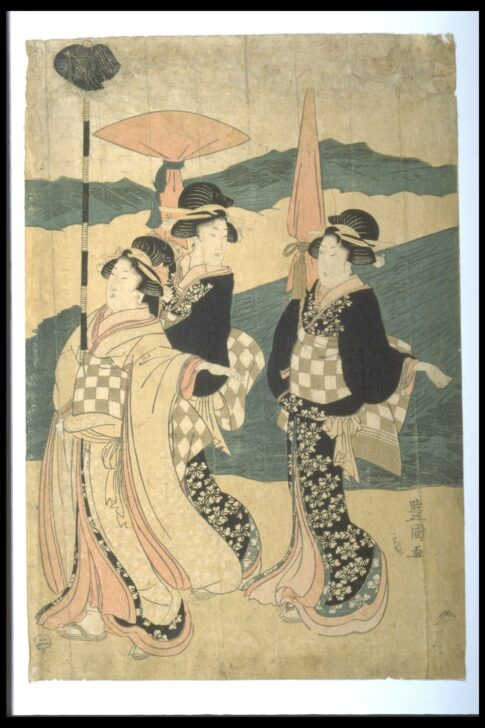Procession of Girls with Fuji Foreheads (Fuji bitai hana no gyôretsu)
Utagawa Toyokuni I

Description
Utagawa Toyokuni I
Japan, 1769–1825
Procession of Girls with Fuji Foreheads
Edo period (1615–1868)
Late 18th to early 19th century
Color woodblock print on paper
Museum Purchase, 1938.4–8
Mount Fuji was frequently shown in the mass-produced woodblock prints known
as ukiyo-e or “pictures of the floating world.” These prints depicted subjects such as
popular fashions or significant landmarks in the Japanese landscape. This set of five
prints combines these two themes by cleverly pairing a woman sporting a trendy
hairstyle known as the “Fuji forehead” (fuji bitai) with Mount Fuji. The hairstyle
emphasized the pale flatness of the forehead and was produced by pinning the hair
so that it showed off the widow’s peak, creating a shape reminiscent of the famous
mountain. While Mount Fuji was visible from the city of Edo (present-day Tokyo), the
women’s proximity to it suggests the artist deliberately flattened the space to create a
more direct parallel between their hair and the mountain.
Subject Matter:
The differences in the women's clothing signify something of status. Typically longer sleeves, as the woman in the lighter kimono wears, symbolize higher status, while the women behind her wear fewer layers and their sleeves are not as long.
Physical Description:
This is the second print in the series of five, as noted by the small number two in the lower left corner. Depicted in this print are three women. One stands in front with lighter colored and heavier clothing. She holds a long stick that appears to be topped off with a shaggy pom pom. The two girls behind her adorn darker colored robes and hold orange umbrellas. All three of their obis are of the same design and their hairstyles do not differ, though the woman in front seems to have more ornamentation. The background is mountainous. To the right of the rightmost woman and at the foot of a mountain is a small vertical inscription. Further into the right corner is another small inscription.
Usage Rights:
If you are interested in using an image for a publication, please visit https://umma.umich.edu/request-image/ for more information and to fill out the online Image Rights and Reproductions Request Form.